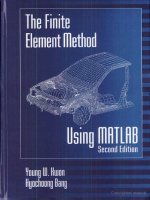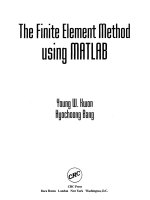Ebook The finite element method in engineering (4th edition) Part 1
Bạn đang xem bản rút gọn của tài liệu. Xem và tải ngay bản đầy đủ của tài liệu tại đây (3.03 MB, 297 trang )
The Finite Element
Method in Engineering
This Page Intentionally Left Blank
The Finite Element
Method in Engineering
FOURTH EDITION
Singiresu S. Rao
Professor and Chairman
Department of Mechanical and Aerospace Engineering
University of Miami, Coral Gables, Florida, USA
Amsterdam • Boston • Heidelberg • London • New York
Paris • San Diego • San Francisco • Singapore • Sydney
•
•
Oxford
Tokyo
Elsevier Butterworth–Heinemann
30 Corporate Drive, Suite 400, Burlington, MA 01803, USA
Linacre House, Jordan Hill, Oxford OX2 8DP, UK
Copyright c 2005, Elsevier Inc. All rights reserved.
No part of this publication may be reproduced, stored in a retrieval system, or transmitted
in any form or by any means, electronic, mechanical, photocopying, recording, or otherwise,
without the prior written permission of the publisher.
Permissions may be sought directly from Elsevier’s Science & Technology Rights
Department in Oxford, UK: phone: (+44) 1865 843830, fax: (+44) 1865 853333,
e-mail: You may also complete your request on-line
via the Elsevier homepage (), by selecting “Customer Support”
and then “Obtaining Permissions.”
Recognizing the importance of preserving what has been written, Elsevier prints its
books on acid-free paper whenever possible.
Library of Congress Cataloging-in-Publication Data
APPLICATION SUBMITTED
British Library Cataloguing-in-Publication Data
A catalogue record for this book is available from the British Library.
ISBN: 0-7506-7828-3
For information on all Butterworth-Heinemann publications
visit our Web site at www.books.elsevier.com.
04
05
06
07
08
09
10
10
9
Printed in the United States of America
8
7
6
5
4
3
2
1
This Page Intentionally Left Blank
CONTENTS
xiii
Preface
Principal Notation
xv
INTRODUCTION
1
1
Overview of Finite Element Method
1.1 Basic Concept
1.2 Historical Background
1.3 General Applicability of the Method
1.4 Engineering Applications of the Finite Element Method
1.5 General Description of the Finite Element Method
1.6 Comparison of Finite Element Method with Other
Methods of Analysis
1.7 Finite Element Program Packages
References
Problems
3
3
3
7
10
10
26
43
43
45
BASIC PROCEDURE
51
2
Discretization of the Domain
2.1 Introduction
2.2 Basic Element Shapes
2.3 Discretization Process
2.4 Node Numbering Scheme
2.5 Automatic Mesh Generation
References
Problems
53
53
53
56
65
68
73
74
3
Interpolation Models
3.1 Introduction
3.2 Polynomial Form of Interpolation Functions
3.3 Simplex, Complex, and Multiplex Elements
3.4 Interpolation Polynomial in Terms of Nodal
Degrees of Freedom
3.5 Selection of the Order of the Interpolation Polynomial
3.6 Convergence Requirements
3.7 Linear Interpolation Polynomials in Terms
of Global Coordinates
3.8 Interpolation Polynomials for Vector Quantities
80
80
82
83
vii
84
85
86
91
97
viii
CONTENTS
3.9
Linear Interpolation Polynomials in Terms
of Local Coordinates
References
Problems
4
5
Higher Order and Isoparametric Elements
4.1 Introduction
4.2 Higher Order One-Dimensional Elements
4.3 Higher Order Elements in Terms of Natural Coordinates
4.4 Higher Order Elements in Terms of Classical
Interpolation Polynomials
4.5 One-Dimensional Elements Using Classical
Interpolation Polynomials
4.6 Two-Dimensional (Rectangular) Elements Using Classical
Interpolation Polynomials
4.7 Continuity Conditions
4.8 Comparative Study of Elements
4.9 Isoparametric Elements
4.10 Numerical Integration
References
Problems
Derivation of Element Matrices and Vectors
5.1 Introduction
5.2 Direct Approach
5.3 Variational Approach
5.4 Solution of Equilibrium Problems Using Variational
(Rayleigh–Ritz) Method
5.5 Solution of Eigenvalue Problems Using Variational
(Rayleigh–Ritz) Method
5.6 Solution of Propagation Problems Using Variational
(Rayleigh–Ritz) Method
5.7 Equivalence of Finite Element and Variational
(Rayleigh–Ritz) Methods
5.8 Derivation of Finite Element Equations Using
Variational (Rayleigh–Ritz) Approach
5.9 Weighted Residual Approach
5.10 Solution of Eigenvalue Problems Using Weighted
Residual Method
5.11 Solution of Propagation Problems Using Weighted
Residual Method
5.12 Derivation of Finite Element Equations Using Weighted
Residual (Galerkin) Approach
5.13 Derivation of Finite Element Equations Using Weighted
Residual (Least Squares) Approach
References
Problems
100
109
110
113
113
113
115
125
131
133
136
139
140
149
154
155
162
162
162
168
174
178
179
180
180
187
192
193
194
198
201
202
CONTENTS
6
7
ix
Assembly of Element Matrices and Vectors
and Derivation of System Equations
6.1 Coordinate Transformation
6.2 Assemblage of Element Equations
6.3 Computer Implementation of the Assembly Procedure
6.4 Incorporation of Boundary Conditions
6.5 Incorporation of Boundary Conditions in
the Computer Program
References
Problems
221
222
223
Numerical Solution of Finite Element Equations
7.1 Introduction
7.2 Solution of Equilibrium Problems
7.3 Solution of Eigenvalue Problems
7.4 Solution of Propagation Problems
7.5 Parallel Processing in Finite Element Analysis
References
Problems
230
230
231
242
258
269
270
272
209
209
211
215
216
APPLICATION TO SOLID MECHANICS PROBLEMS
277
8
Basic Equations and Solution Procedure
8.1 Introduction
8.2 Basic Equations of Solid Mechanics
8.3 Formulations of Solid and Structural Mechanics
8.4 Formulation of Finite Element Equations (Static Analysis)
References
Problems
279
279
279
295
300
305
306
9
Analysis of Trusses, Beams, and Frames
9.1 Introduction
9.2 Space Truss Element
9.3 Beam Element
9.4 Space Frame Element
9.5 Planar Frame Element
9.6 Computer Program for Frame Analysis
References
Problems
309
309
309
319
321
331
334
341
342
10 Analysis of Plates
10.1 Introduction
10.2 Triangular Membrane Element
10.3 Numerical Results with Membrane Element
10.4 Computer Program for Plates under Inplane Loads
10.5 Bending Behavior of Plates
10.6 Finite Element Analysis of Plate Bending
357
357
357
365
371
374
378
x
CONTENTS
10.7
10.8
10.9
Triangular Plate Bending Element
Numerical Results with Bending Elements
Analysis of Three-Dimensional Structures Using
Plate Elements
10.10 Computer Program for Three-Dimensional Structures
Using Plate Elements
References
Problems
379
383
387
391
391
392
11 Analysis of Three-Dimensional Problems
11.1 Introduction
11.2 Tetrahedron Element
11.3 Hexahedron Element
11.4 Analysis of Solids of Revolution
References
Problems
399
399
399
403
408
416
417
12 Dynamic Analysis
12.1 Dynamic Equations of Motion
12.2 Consistent and Lumped Mass Matrices
12.3 Consistent Mass Matrices in Global Coordinate System
12.4 Free Vibration Analysis
12.5 Computer Program for Eigenvalue Analysis of
Three-Dimensional Structures
12.6 Dynamic Response Using Finite Element Method
12.7 Nonconservative Stability and Flutter Problems
12.8 Substructures Method
References
Problems
421
421
424
425
433
APPLICATION TO HEAT TRANSFER PROBLEMS
465
13 Formulation and Solution Procedure
13.1 Introduction
13.2 Basic Equations of Heat Transfer
13.3 Governing Equation for Three-Dimensional Bodies
13.4 Statement of the Problem
13.5 Derivation of Finite Element Equations
References
Problems
467
467
467
469
473
474
479
480
14 One-Dimensional Problems
14.1 Introduction
14.2 Straight Uniform Fin Analysis
14.3 Computer Program for One-Dimensional Problems
14.4 Tapered Fin Analysis
14.5 Analysis of Uniform Fins Using Quadratic Elements
482
482
482
488
490
493
440
444
455
455
455
458
CONTENTS
14.6 Unsteady State Problems
14.7 Heat Transfer Problems with Radiation
14.8 Computer Program for Problems with Radiation
References
Problems
xi
496
502
507
508
509
15 Two-Dimensional Problems
15.1 Introduction
15.2 Solution
15.3 Computer Program
15.4 Unsteady State Problems
References
Problems
514
514
514
527
528
528
529
16 Three-Dimensional Problems
16.1 Introduction
16.2 Axisymmetric Problems
16.3 Computer Program for Axisymmetric Problems
16.4 Three-Dimensional Heat Transfer Problems
16.5 Unsteady State Problems
References
Problems
533
533
533
541
543
549
550
551
APPLICATION TO FLUID MECHANICS PROBLEMS
555
17 Basic Equations of Fluid Mechanics
17.1 Introduction
17.2 Basic Characteristics of Fluids
17.3 Methods of Describing the Motion of a Fluid
17.4 Continuity Equation
17.5 Equations of Motion or Momentum Equations
17.6 Energy, State, and Viscosity Equations
17.7 Solution Procedure
17.8 Inviscid Fluid Flow
17.9 Irrotational Flow
17.10 Velocity Potential
17.11 Stream Function
17.12 Bernoulli Equation
References
Problems
557
557
557
558
559
560
565
567
567
568
569
570
572
573
574
18 Inviscid and Incompressible Flows
18.1 Introduction
18.2 Potential Function Formulation
18.3 Finite Element Solution Using the Galerkin Approach
575
575
576
578
xii
CONTENTS
18.4 Stream Function Formulation
18.5 Computer Program for Potential Function Approach
References
Problems
585
588
589
590
19 Viscous and Non-Newtonian Flows
19.1 Introduction
19.2 Stream Function Formulation (Using Variational Approach)
19.3 Velocity–Pressure Formulation (Using Galerkin Approach)
19.4 Solution of Navier–Stokes Equations
19.5 Stream Function–Vorticity Formulation
19.6 Flow of Non-Newtonian Fluids
19.7 Other Developments
References
Problems
594
594
595
601
603
604
608
613
614
616
ADDITIONAL APPLICATIONS
619
20 Solution of Quasi-Harmonic Equations
20.1 Introduction
20.2 Finite Element Equations for Steady-State Problems
20.3 Solution of Poisson’s Equation
20.4 Computer Program for Torsion Analysis
20.5 Transient Field Problems
References
Problems
621
621
623
624
632
633
637
638
21 Solution of Helmholtz Equation
21.1 Introduction
21.2 Finite Element Solution
21.3 Numerical Examples
References
Problems
642
642
642
644
647
648
22 Solution of Reynolds Equation
22.1 Hydrodynamic Lubrication
22.2 Finite Element Solution
22.3 Numerical Examples
References
Problems
650
650
651
653
655
656
Appendix A Green–Gauss Theorem
657
Index
659
PREFACE
The finite element method is a numerical method that can be used for the accurate
solution of complex engineering problems. The method was first developed in 1956 for
the analysis of aircraft structural problems. Thereafter, within a decade, the potentialities of the method for the solution of different types of applied science and engineering
problems were recognized. Over the years, the finite element technique has been so well
established that today it is considered to be one of the best methods for solving a wide
variety of practical problems efficiently. In fact, the method has become one of the active
research areas for applied mathematicians. One of the main reasons for the popularity of
the method in different fields of engineering is that once a general computer program is
written, it can be used for the solution of any problem simply by changing the input data.
The objective of this book is to introduce the various aspects of finite element method
as applied to engineering problems in a systematic manner. It is attempted to give details
of development of each of the techniques and ideas from basic principles. New concepts are
illustrated with simple examples wherever possible. Several Fortran computer programs
are given with example applications to serve the following purposes:
– to enable the student to understand the computer implementation of the theory
developed;
– to solve specific problems;
– to indicate procedure for the development of computer programs for solving any
other problem in the same area.
The source codes of all the Fortran computer programs can be found at the Web site
for the book, www.books.elsevier.com. Note that the computer programs are intended for
use by students in solving simple problems. Although the programs have been tested, no
warranty of any kind is implied as to their accuracy.
After studying the material presented in the book, a reader will not only be able to
understand the current literature of the finite element method but also be in a position to
develop short computer programs for the solution of engineering problems. In addition, the
reader will be in a position to use the commercial software, such as ABAQUS, NASTRAN,
and ANSYS, more intelligently.
The book is divided into 22 chapters and an appendix. Chapter 1 gives an introduction
and overview of the finite element method. The basic approach and the generality of
the method are illustrated through simple examples. Chapters 2 through 7 describe the
basic finite element procedure and the solution of the resulting equations. The finite
element discretization and modeling, including considerations in selecting the number
and types of elements, is discussed in Chapter 2. The interpolation models in terms of
Cartesian and natural coordinate systems are given in Chapter 3. Chapter 4 describes the
higher order and isoparametric elements. The use of Lagrange and Hermite polynomials
is also discussed in this chapter. The derivation of element characteristic matrices and
vectors using direct, variational, and weighted residual approaches is given in Chapter 5.
xiii
xiv
PREFACE
The assembly of element characteristic matrices and vectors and the derivation of system
equations, including the various methods of incorporating the boundary conditions, are
indicated in Chapter 6. The solutions of finite element equations arising in equilibrium,
eigenvalue, and propagation (transient or unsteady) problems, along with their computer
implementation, are briefly outlined in Chapter 7.
The application of the finite element method to solid and structural mechanics problems is considered in Chapters 8 through 12. The basic equations of solid
mechanics — namely, the internal and external equilibrium equations, stress–strain relations, strain–displacement relations and compatibility conditions — are summarized in
Chapter 8. The analysis of trusses, beams, and frames is the topic of Chapter 9. The
development of inplane and bending plate elements is discussed in Chapter 10. The analysis of axisymmetric and three-dimensional solid bodies is considered in Chapter 11. The
dynamic analysis, including the free and forced vibration, of solid and structural mechanics
problems is outlined in Chapter 12.
Chapters 13 through 16 are devoted to heat transfer applications. The basic equations
of conduction, convection, and radiation heat transfer are summarized and the finite
element equations are formulated in Chapter 13. The solutions of one-, two-, and threedimensional heat transfer problems are discussed in Chapters 14–16, respectively. Both
the steady state and transient problems are considered. The application of the finite
element method to fluid mechanics problems is discussed in Chapters 17–19. Chapter 17
gives a brief outline of the basic equations of fluid mechanics. The analysis of inviscid
incompressible flows is considered in Chapter 18. The solution of incompressible viscous
flows as well as non-Newtonian fluid flows is considered in Chapter 19. Chapters 20–22
present additional applications of the finite element method. In particular, Chapters 20–22
discuss the solution of quasi-harmonic (Poisson), Helmholtz, and Reynolds equations,
respectively. Finally, Green–Gauss theorem, which deals with integration by parts in two
and three dimensions, is given in Appendix A.
This book is based on the author’s experience in teaching the course to engineering
students during the past several years. A basic knowledge of matrix theory is required
in understanding the various topics presented in the book. More than enough material
is included for a first course at the senior or graduate level. Different parts of the book
can be covered depending on the background of students and also on the emphasis to
be given on specific areas, such as solid mechanics, heat transfer, and fluid mechanics.
The student can be assigned a term project in which he/she is required to either modify
some of the established elements or develop new finite elements, and use them for the
solution of a problem of his/her choice. The material of the book is also useful for self
study by practicing engineers who would like to learn the method and/or use the computer
programs given for solving practical problems.
I express my appreciation to the students who took my courses on the finite element
method and helped me improve the presentation of the material. Finally, I thank my wife
Kamala for her tolerance and understanding while preparing the manuscript.
Miami
May 2004
S. S. Rao
PRINCIPAL NOTATION
a
ax , ay , az
A
A(e)
Ai (Aj )
b
B
c
cv
C1 , C2 , . . .
[C]
D
[D]
E
E (e)
Eii
f1 (x), f2 (x), . . .
F
g
G
Gij
h
(0)
Hoi (x)
(j)
Hki
i
I
i, (I)
I (e)
Izz
J
j (J)
[J]
length of a rectangular element
components of acceleration along x, y, z directions of a fluid
area of cross section of a one-dimensional element; area of a triangular
(plate) element
cross-sectional area of one-dimensional element e
cross-sectional area of a tapered one-dimensional element at node i(j)
width of a rectangular element
body force vector in a fluid = {Bx , By , Bz }T
specific heat
specific heat at constant volume
constants
compliance matrix; damping matrix
flexural rigidity of a plate
elasticity matrix (matrix relating stresses and strains)
Young’s modulus; total number of elements
Young’s modulus of element e
Young’s modulus in a plane defined by axis i
functions of x
shear force in a beam
acceleration due to gravity
shear modulus
shear modulus in plane ij
convection heat transfer coefficient
Lagrange polynomial associated with node i
jth order Hermite polynomial
(−1)1/2
functional to be extremized;
potential energy;
area moment of inertia of a beam
unit vector parallel to x(X) axis
contribution of element e to the functional I
area moment of inertia of a cross section about z axis
polar moment of inertia of a cross section
unit vector parallel to y(Y ) axis
Jacobian matrix
xv
xvi
k
k x , ky , kz
kr , kθ , k z
k (K)
[k(e) ]
(e)
[K (e) ] = [Kij ]
[K] = [Kij ]
[K
] = [K
]
∼
∼ ij
l
l(e)
lx , ly , lz
lox , mox , nox
lij , mij , nij
L
L1 , L2
L1 , L2 , L3
L1 , L2 , L3 , L4
£
m
M
Mx , My , Mxy
Mz
[m(e) ]
[M (e) ]
[M ]
]
[M
∼
n
Ni
[N ]
p
P
Pc
Pi (Pj )
Px , Py , Pz
p (e)
(e)
(e)
pb (Pb )
PRINCIPAL NOTATION
thermal conductivity
thermal conductivities along x, y, z axes
thermal conductivities along r, θ, z axes
unit vector parallel to z(Z) axis
stiffness matrix of element e in local coordinate system
stiffness matrix of element e in global coordinate system
stiffness (characteristic) matrix of complete body after incorporation
of boundary conditions
stiffness (characteristic) matrix of complete body before
incorporation of boundary conditions
length of one-dimensional element
length of the one-dimensional element e
direction cosines of a line
direction cosines of x axis
direction cosines of a bar element with nodes i and j
total length of a bar or fin; Lagrangian
natural coordinates of a line element
natural coordinates of a triangular element
natural coordinates of a tetrahedron element
distance between two nodes
mass of beam per unit length
bending moment in a beam; total number of degrees of freedom
in a body
bending moments in a plate
torque acting about z axis on a prismatic shaft
mass matrix of element e in local coordinate system
mass matrix of element e in global coordinate system
mass matrix of complete body after incorporation of
boundary conditions
mass matrix of complete body before incorporation of
boundary conditions
normal direction
interpolation function associated with the ith nodal degree of freedom
matrix of shape (nodal interpolation) functions
distributed load on a beam or plate; fluid pressure
perimeter of a fin
vector of concentrated nodal forces
perimeter of a tapered fin at node i(j)
external concentrated loads parallel to x, y, z axes
load vector of element e in local coordinate system
load vector due to body forces of element e in local (global)
coordinate system
PRINCIPAL NOTATION
(e)
(e)
(e)
(e)
pi (Pi
)
ps (Ps )
(e)
P (e) = {Pi
P = {Pi }
= {P
}
P
∼
∼i
q
q˙
qx
Qi
Qx , Qy
Qx , Qy , Qz
q (e) (Q (e) )
Q
∼
Qj
r, s
r, s, t
r, θ, z
(ri , si , ti )
R
S
S1 , S2
S (e)
(e)
(e)
S1 , S2
t
T
Ti
T0
T∞
(e)
Ti
T (e)
}
load vector due to initial strains of element e in local (global)
coordinate system
load vector due to surface forces of element e in local (global)
coordinate system
vector of nodal forces (characteristic vector) of element e in global
coordinate system
vector of nodal forces of body after incorporation of
boundary conditions
vector of nodal forces of body before incorporation of
boundary conditions
rate of heat flow
rate of heat generation per unit volume
rate of heat flow in x direction
mass flow rate of fluid across section i
vertical shear forces in a plate
external concentrated moments parallel to x, y, z axes
vector of nodal displacements (field variables) of element e in local
(global) coordinate system
vector of nodal displacements of body before incorporation of
boundary conditions
mode shape corresponding to the frequency ωj
natural coordinates of a quadrilateral element
natural coordinates of a hexahedron element
radial, tangential, and axial directions
values of (r, s, t) at node i
radius of curvature of a deflected beam;
residual;
region of integration;
dissipation function
surface of a body
part of surface of a body
surface of element e
part of surface of element e
time; thickness of a plate element
temperature;
temperature change;
kinetic energy of an elastic body
temperature at node i
temperature at the root of fin
surrounding temperature
temperature at node i of element e
vector of nodal temperatures of element e
xvii
xviii
T
∼
u
u, v, w
U
V
V
w
W
Wi
Wp
W (e)
x
(xc , yc )
(xi , yi , zi )
(Xi , Yi , Zi )
α
αi
δ
εii
εij
ε(e)
ε
ε0
θ
[λ(e) ]
(t)
ηj
μ
ν
νij
π
πc
πp
πR
π (e)
ρ
σii
PRINCIPAL NOTATION
vector of nodal temperatures of the body before incorporation of
boundary conditions
flow velocity along x direction; axial displacement
components of displacement parallel to x, y, z axes; components of
velocity along x, y, z directions in a fluid (Chapter 17)
vector of displacements = {u, v, w}T
volume of a body
velocity vector = {u, v, w}T (Chapter 17)
transverse deflection of a beam
amplitude of vibration of a beam
value of W at node i
work done by external forces
vector of nodal displacements of element e
x coordinate;
axial direction
coordinates of the centroid of a triangular element
(x, y, z) coordinates of node i
global coordinates (X, Y, Z) of node i
coefficient of thermal expansion
ith generalized coordinate
variation operator
normal strain parallel to ith axis
shear strain in ij plane
strain in element e
strain vector = {εxx , εyy , εzz , εxy , εyz , εzx }T for a
three-dimensional body;
= {εrr , εθθ , εzz , εrz }T for an axisymmetric body
initial strain vector
torsional displacement or twist
coordinate transformation matrix of element e
jth generalized coordinate
dynamic viscosity
Poisson’s ratio
Poisson’s ratio in plane ij
potential energy of a beam;
strain energy of a solid body
complementary energy of an elastic body
potential energy of an elastic body
Reissner energy of an elastic body
strain energy of element e
density of a solid or fluid
normal stress parallel to ith axis
PRINCIPAL NOTATION
σij
σ (e)
σ
τ
φ
φx , φy , φz
φ
φ¯
Φ
Φx , Φ y , Φ z
Φi
Φ∗i
(e)
Φi
Φ (e)
Φ
Φ
∼
ψ
ω
ωj
ωx
ω
˜i
Ω
superscript e
arrow over a
symbol (X)
X T ([ ]T )
dot over a
symbol (x)
˙
shear stress in ij plane
stress in element e
stress vector = {σxx , σyy , σzz , σxy , σyz , σzx }T for a
three-dimensional body;
= {σrr , σθθ , σzz , σrz }T for an axisymmetric body
shear stress in a fluid
field variable;
axial displacement;
potential function in fluid flow
body force per unit volume parallel to x, y, z axes
vector valued field variable with components u, v, and w
vector of prescribed body forces
dissipation function for a fluid
surface (distributed) forces parallel to x, y, z axes
ith field variable
prescribed value of φi
value of the field variable φ at node i of element e
vector of nodal values of the field variable of element e
vector of nodal values of the field variables of complete body after
incorporation of boundary conditions
vector of nodal values of the field variables of complete body before
incorporation of boundary conditions
stream function in fluid flow
frequency of vibration
jth natural frequency of a body
rate of rotation of fluid about x axis
approximate value of ith natural frequency
body force potential in fluid flow
element e
⎧ ⎫
⎪
X ⎪
⎪
⎬
⎨ 1⎪
column vector X = X2
⎪
⎪
⎪
⎭
⎩ .. ⎪
.
transpose of X([ ])
dx
derivative with respect to time x˙ =
dt
xix
This Page Intentionally Left Blank
INTRODUCTION
This Page Intentionally Left Blank
1
OVERVIEW OF FINITE ELEMENT
METHOD
1.1 BASIC CONCEPT
The basic idea in the finite element method is to find the solution of a complicated problem
by replacing it by a simpler one. Since the actual problem is replaced by a simpler one
in finding the solution, we will be able to find only an approximate solution rather than
the exact solution. The existing mathematical tools will not be sufficient to find the exact
solution (and sometimes, even an approximate solution) of most of the practical problems.
Thus, in the absence of any other convenient method to find even the approximate solution
of a given problem, we have to prefer the finite element method. Moreover, in the finite
element method, it will often be possible to improve or refine the approximate solution by
spending more computational effort.
In the finite element method, the solution region is considered as built up of many
small, interconnected subregions called finite elements. As an example of how a finite
element model might be used to represent a complex geometrical shape, consider the
milling machine structure shown in Figure 1.1(a). Since it is very difficult to find the
exact response (like stresses and displacements) of the machine under any specified cutting
(loading) condition, this structure is approximated as composed of several pieces as shown
in Figure 1.1(b) in the finite element method. In each piece or element, a convenient
approximate solution is assumed and the conditions of overall equilibrium of the structure
are derived. The satisfaction of these conditions will yield an approximate solution for the
displacements and stresses. Figure 1.2 shows the finite element idealization of a fighter
aircraft.
1.2 HISTORICAL BACKGROUND
Although the name of the finite element method was given recently, the concept dates
back for several centuries. For example, ancient mathematicians found the circumference
of a circle by approximating it by the perimeter of a polygon as shown in Figure 1.3.
In terms of the present-day notation, each side of the polygon can be called a
“finite element.” By considering the approximating polygon inscribed or circumscribed,
one can obtain a lower bound S (l) or an upper bound S (u) for the true circumference S.
Furthermore, as the number of sides of the polygon is increased, the approximate values
3
4
OVERVIEW OF FINITE ELEMENT METHOD
Figure 1.1. Representation of a Milling Machine Structure by Finite Elements.
Figure 1.2. Finite Element Mesh of a Fighter Aircraft (Reprinted with Permission from Anamet
Laboratories, Inc.).









